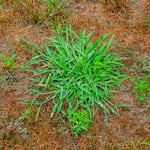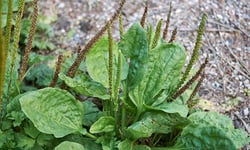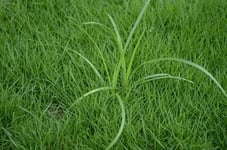Ultimate Guide: Identifying and Controlling Lawn Weeds
Maintaining a healthy lawn involves more than just mowing and watering. Effective weed control is also crucial.

Weeds steal nutrients, water, and sunlight from your grass, making your lawn look unhealthy and patchy. Knowing what kinds of weeds you have and how to get rid of them can make your lawn look great.
This guide will help you learn how to spot common lawn weeds, pick the best ways to control them, and use the right treatments to keep your lawn green and weed-free.
Types of Lawn Weeds
Weeds come in many shapes and sizes, and each type can affect your lawn differently. Here are some common types of lawn weeds:
Dandelions
- Description: Bright yellow flowers that turn into white, fluffy seed heads.
- Characteristics: Deep taproots make them tough to pull out completely.
- Season: Spring and fall.
Crabgrass
- Description: Low-growing grass with wide, flat blades.
- Characteristics: Spreads quickly and thrives in hot, dry conditions.
- Season: Late spring to early fall.
Clover
- Description: Small, white, or pink flowers with round leaves.
- Characteristics: Adds nitrogen to the soil, but can crowd out grass.
- Season: Spring and summer.
Broadleaf Plantain
- Description: Broad, flat leaves that grow close to the ground with small, greenish flowers.
- Characteristics: Tolerant of compacted soil and low mowing heights.
- Season: Throughout the growing season.
Nutsedge
- Description: Grass-like plant with a triangular stem and yellowish-green leaves.
- Characteristics: Grows faster than most lawn grasses and prefers wet conditions.
- Season: Summer.
By learning to identify these common lawn weeds, you can take the first step toward effective control and a healthier lawn.
How to Identify Lawn Weeds
Identifying lawn weeds is the first step to controlling them effectively. Here are some tips to help you recognize different types of weeds in your lawn:
Look at the Leaves
- Shape: Notice if the leaves are broad, narrow, or have unique shapes.
- Edges: Check if the leaf edges are smooth, serrated, or lobed.
- Arrangement: See if the leaves grow in pairs, clusters, or alternately along the stem.
Examine the Flowers
- Color: Note the color of the flowers; common weed flowers are yellow, white, or purple.
- Size and Shape: Look at the flower's size and shape, which can help in identifying the weed.
Check the Growth Pattern
- Height: Determine how tall the weed grows compared to your grass.
- Spread: Observe if the weed grows in clusters, spreads out, or forms a mat.
Root System
- Type: Identify if the weed has a taproot (single deep root), fibrous roots (many thin roots), or a rhizome (underground stem).
- Depth: Some weeds have shallow roots, while others have deep roots that are harder to remove.
Seasonal Appearance
- Spring and Summer: Some weeds, like dandelions and crabgrass, are more common in warmer months.
- Fall and Winter: Others, like broadleaf plantain, can appear in cooler weather.
By closely examining these features, you can accurately identify the weeds in your lawn and choose the best control methods for each type.
Best Weed Control Methods
Keeping your lawn free of weeds requires using the right control methods. Here are some of the best ways to control weeds:
Manual Weed Removal
- Hand Pulling: For small areas or individual weeds, hand pulling is effective. Make sure to remove the entire root.
- Weeding Tools: Tools like weed pullers and hoes can make the job easier and more thorough.
Organic Weed Control
- Mulching: Covering soil with mulch can prevent weeds from getting sunlight and growing.
- Vinegar Solutions: Spraying weeds with vinegar can kill them without using chemicals.
- Corn Gluten Meal: This natural product can prevent weed seeds from sprouting.
Chemical Weed Control
- Pre-emergent Herbicides: Apply these before weeds appear to stop seeds from germinating. Best used in early spring.
- Post-emergent Herbicides: Use these after weeds have grown to kill them. They can be selective (targeting specific weeds) or non-selective (killing all plants they touch).
Cultural Practices
- Proper Mowing: Keep your grass at the right height to shade out weeds. Avoid cutting too short.
- Adequate Watering: Water your lawn deeply and infrequently to encourage strong grass roots, which can outcompete weeds.
- Fertilization: A healthy lawn with proper nutrients can resist weed invasion. Follow a regular fertilization schedule.
Integrated Weed Management
- Combination Approach: Use a mix of manual, organic, chemical, and cultural practices for the best results.
- Monitoring: Regularly inspect your lawn for new weeds and address them quickly.
By using these methods, you can effectively control weeds and maintain a healthy, beautiful lawn.
Organic Weed Control
If you prefer natural methods for weed control, there are several organic options available that are effective and eco-friendly. Here are some popular organic weed control methods:
Mulching
- Benefits: Mulch helps to block sunlight from reaching weed seeds, preventing them from growing.
- Materials: Use organic materials like straw, wood chips, or grass clippings.
- Application: Spread a thick layer (2-3 inches) around plants and garden beds.
Vinegar Solutions
- How It Works: The acetic acid in vinegar can kill weeds by drying them out.
- Recipe: Use a spray bottle to apply undiluted white vinegar directly onto the weeds.
- Best For: Spot treatment of weeds on sidewalks, driveways, and garden beds.
Corn Gluten Meal
- Function: Acts as a pre-emergent herbicide by inhibiting root formation in seedlings.
- Application: Spread corn gluten meal on your lawn early in the spring before weed seeds germinate.
- Benefits: Also adds nitrogen to the soil, benefiting your grass.
Boiling Water
- Method: Pour boiling water directly onto weeds to kill them.
- Best For: Small areas or isolated weeds, especially in cracks of sidewalks or driveways.
Hand Weeding
- Technique: Pull weeds out by hand, ensuring you remove the entire root.
- Tools: Use weeding tools to make the job easier, especially for weeds with deep roots.
Homemade Herbicide Recipes
- Ingredients: Common ingredients include salt, soap, and vinegar.
- Recipe Example: Mix 1 gallon of white vinegar, 1 cup of salt, and 1 tablespoon of dish soap. Spray directly onto weeds.
- Caution: Use sparingly as salt can affect soil health.
Using these organic methods, you can control weeds in your lawn and garden without harming the environment or using synthetic chemicals.
Pre-emergent Weed Control
Pre-emergent weed control is an effective way to prevent weeds from sprouting in the first place. Here’s how it works and how to apply it:
1. What Are Pre-emergent Herbicides?
- Definition: Pre-emergent herbicides are chemicals applied to the soil to stop weed seeds from germinating.
- Function: They create a barrier in the soil that inhibits the growth of new weeds but won't affect existing plants.
2. When to Apply Pre-emergent Herbicides
- Timing: Apply in early spring before weed seeds begin to germinate, usually when soil temperatures reach around 55°F (13°C).
- Seasonal Application: In some regions, a second application in late summer or early fall can help control winter weeds.
3. How to Apply Pre-emergent Herbicides
- Preparation: Clear your lawn of existing weeds and debris to ensure even application.
- Spreader: Use a broadcast spreader to apply granular herbicides evenly across your lawn.
- Watering: Water your lawn lightly after application to help the herbicide penetrate the soil and activate.
4. Types of Pre-emergent Herbicides
- Selective Herbicides: Target specific types of weeds without harming your grass. Examples include products for crabgrass control.
- Non-selective Herbicides: Prevent all types of seeds from germinating, which can be useful in garden beds or non-turf areas.
5. Benefits of Pre-emergent Herbicides
- Weed Prevention: Effective in stopping weeds before they become a problem.
- Less Manual Labor: Reduces the need for hand weeding or post-emergent treatments.
- Lawn Health: Helps maintain a healthier lawn by reducing weed competition.
6. Tips for Success
- Consistent Application: Apply pre-emergent herbicides at the correct times each year for the best results.
- Proper Coverage: Ensure even coverage across the lawn to prevent gaps where weeds can grow.
- Follow Instructions: Always follow the manufacturer’s instructions for application rates and safety guidelines.
By using pre-emergent herbicides effectively, you can significantly reduce the number of weeds in your lawn, leading to a healthier, more attractive yard.
Post-emergent Weed Control
Post-emergent weed control is used to tackle weeds that have already sprouted in your lawn. Here’s how to effectively use post-emergent herbicides:
1. What Are Post-emergent Herbicides?
- Definition: Post-emergent herbicides are chemicals designed to kill weeds after they have emerged from the soil.
- Function: They work by being absorbed into the plant tissue, disrupting growth and eventually killing the weed.
2. When to Apply Post-emergent Herbicides
- Timing: Apply when weeds are actively growing, typically in late spring through early fall.
- Conditions: Ensure the weather is calm and dry, as rain shortly after application can wash away the herbicide.
3. How to Apply Post-emergent Herbicides
- Preparation: Identify the specific weeds in your lawn to choose the right herbicide.
- Spot Treatment: For isolated weeds, use a handheld sprayer to apply the herbicide directly to the weed.
- Broadcast Application: For widespread weed problems, use a hose-end or tank sprayer for even coverage across the lawn.
4. Types of Post-emergent Herbicides
- Selective Herbicides: Target specific types of weeds without harming your grass. Examples include products that target broadleaf weeds like dandelions and clover.
- Non-selective Herbicides: Kill all plants they come into contact with, useful for clearing areas of all vegetation but should be used with caution in lawns.
5. Benefits of Post-emergent Herbicides
- Effective Control: Quickly reduces the presence of established weeds in your lawn.
- Targeted Treatment: Allows for precise application to problem areas without affecting the entire lawn.
- Versatility: Available in both liquid and granular forms, offering flexibility in application methods.
6. Tips for Success
- Follow Instructions: Always read and follow the manufacturer’s guidelines for the best results and safety.
- Avoid Mowing: Do not mow your lawn 2-3 days before and after application to allow the herbicide to be fully absorbed.
- Proper Identification: Correctly identify the weed type to choose the most effective herbicide.
Using post-emergent herbicides properly can help you eliminate existing weeds and restore the beauty and health of your lawn.
DIY Weed Control
For those who prefer to tackle weed problems themselves, there are several effective DIY weed control methods you can use. Here are some practical and budget-friendly ways to keep your lawn weed-free:
1. Hand Pulling
- Method: Pull weeds out by hand, ensuring you remove the entire root to prevent regrowth.
- Tools: Use gardening gloves and tools like weed pullers or trowels for better grip and ease.
2. Homemade Weed Killers
- Vinegar Spray: Mix white vinegar with a few drops of dish soap and spray directly onto weeds.
- Salt Solution: Dissolve salt in water and apply to the base of weeds, but use sparingly to avoid harming the soil.
- Boiling Water: Pour boiling water over weeds to kill them instantly, ideal for driveways and sidewalks.
3. Mulching
- Benefits: Mulch blocks sunlight from reaching weed seeds, preventing them from sprouting.
- Materials: Use organic mulches like wood chips, straw, or grass clippings around plants and in garden beds.
4. Corn Gluten Meal
- Application: Spread corn gluten meal on your lawn to prevent weed seeds from germinating.
- Timing: Apply in early spring and again in late summer for the best results.
5. Flame Weeding
- Technique: Use a propane torch to apply heat directly to the weeds, causing them to wilt and die.
- Caution: Be careful around dry areas and flammable materials to prevent accidental fires.
6. Smothering Weeds
- Method: Cover large areas of weeds with cardboard, newspaper, or black plastic to block sunlight and kill the weeds.
- Duration: Leave the covering in place for several weeks to ensure the weeds are fully smothered.
7. Proper Lawn Maintenance
- Mowing: Keep your grass at the recommended height to shade out weeds and prevent them from establishing.
- Watering: Water deeply and infrequently to promote strong grass roots, making it harder for weeds to compete.
- Fertilizing: Regularly fertilize your lawn to maintain its health and resilience against weeds.
By using these DIY methods, you can effectively control weeds in your lawn without the need for professional services or harsh chemicals.
Chemical Weed Control
Chemical weed control involves using herbicides to manage and eliminate weeds. When used correctly, these products can be highly effective. Here’s a guide to understanding and applying chemical weed control:
Types of Chemical Herbicides
- Selective Herbicides: Target specific types of weeds without harming your grass. Commonly used for broadleaf weeds like dandelions.
- Non-selective Herbicides: Kill all plants they come into contact with, useful for clearing areas but must be used with caution in lawns.
- Systemic Herbicides: Absorbed by the plant and transported throughout, killing it from the inside out.
- Contact Herbicides: Kill the part of the plant they come into contact with but may not eliminate the root.
When to Use Chemical Herbicides
- Pre-emergent: Apply in early spring to prevent weed seeds from germinating.
- Post-emergent: Use when weeds are actively growing, typically in late spring through early fall.
Application Methods
- Spot Treatment: Use a handheld sprayer to apply herbicide directly to individual weeds. Ideal for small infestations.
- Broadcast Treatment: Use a hose-end or tank sprayer to cover large areas uniformly. Best for widespread weed problems.
- Granular Form: Spread granules using a broadcast spreader and water them in to activate.
Safety Precautions
- Protective Gear: Wear gloves, long sleeves, and eye protection when handling herbicides.
- Weather Conditions: Apply on a calm, dry day to prevent drift and ensure the herbicide stays where you apply it.
- Pets and Children: Keep them off the treated area until the herbicide has dried completely.
Proper Use and Storage
- Instructions: Always follow the manufacturer’s guidelines for mixing, application rates, and timing.
- Storage: Keep herbicides in a cool, dry place away from children and pets. Store in original containers with labels intact.
- Disposal: Dispose of empty containers and unused herbicides according to local regulations.
Benefits of Chemical Weed Control
- Efficiency: Quickly reduces and eliminates weed populations.
- Versatility: Suitable for various types of weeds and infestation levels.
- Longevity: Provides long-lasting control when applied correctly.
Drawbacks to Consider
- Environmental Impact: Potential to harm non-target plants and wildlife if not used carefully.
- Resistance: Overuse can lead to herbicide-resistant weeds.
- Soil Health: Can affect soil microorganisms and overall soil health with repeated use.
By understanding and properly using chemical herbicides, you can effectively control weeds in your lawn, ensuring a healthy and attractive outdoor space.
Professional Weed Removal Services
Sometimes, the best way to tackle a weed problem is to call in the professionals. Professional weed removal services offer expertise and resources that can make a significant difference in lawn care. Here’s what you need to know about hiring professional weed control:
Benefits of Professional Services
- Expert Knowledge: Professionals can identify and treat a wide variety of weeds, knowing which methods work best for each type.
- Effective Treatments: They use high-quality products and equipment not always available to homeowners.
- Time-Saving: Hiring a service saves you time and effort, allowing you to enjoy your lawn without the hard work.
Services Offered
- Initial Assessment: Professionals will assess your lawn to identify weed types and the extent of the infestation.
- Customized Treatment Plans: They create tailored plans based on your lawn’s specific needs, including pre-emergent and post-emergent treatments.
- Regular Maintenance: Many services offer ongoing maintenance plans to keep your lawn weed-free throughout the year.
What to Expect
- Scheduled Visits: Technicians will visit your property on a set schedule to apply treatments and monitor progress.
- Progress Reports: Some services provide detailed reports on the treatments used and the condition of your lawn.
- Customer Support: Professional services often offer support and advice between visits to address any concerns.
Choosing the Right Service
- Reputation: Look for companies with good reviews and a strong reputation in your area.
- Certifications: Ensure the company is licensed and certified to apply herbicides and other treatments.
- Guarantees: Some companies offer guarantees on their work, providing peace of mind if the weeds return.
Cost Considerations
- Initial Cost: Professional services can be more expensive upfront than DIY methods.
- Long-Term Value: Consider the long-term benefits of a healthy, weed-free lawn and the potential savings in time and effort.
- Packages: Many companies offer packages or discounts for regular maintenance plans, making it more affordable.
Preparing for Professional Treatment
- Clear Communication: Discuss your specific concerns and goals with the service provider to ensure they understand your needs.
- Preparation: Follow any pre-treatment instructions provided, such as watering your lawn or avoiding mowing before the visit.
- Post-Treatment Care: Follow post-treatment advice, such as keeping off the treated areas for a specified period.
By hiring professional weed removal services, you can ensure that your lawn receives the best care possible, leading to a healthier and more attractive outdoor space.
Lawn Weed Treatment Schedule
Maintaining a weed-free lawn requires a well-planned treatment schedule. Here’s a seasonal guide to help you keep your lawn healthy and weed-free year-round:
Spring (March - May)
Early Spring (March)
- Pre-emergent Herbicides: Apply to prevent weed seeds from germinating.
- Weed Identification: Start monitoring your lawn for early signs of weed growth.
- Fertilization: Apply a balanced fertilizer to promote healthy grass growth.
Mid to Late Spring (April - May)
- Post-emergent Herbicides: Apply to any visible weeds that have emerged.
- Hand Pulling: Remove any remaining weeds by hand to prevent them from spreading.
- Mowing: Keep your grass at the recommended height to shade out weeds.
Summer (June - August)
Early Summer (June)
- Post-emergent Herbicides: Continue treating any new weed growth.
- Watering: Water deeply and infrequently to strengthen grass roots and make it harder for weeds to establish.
Mid to Late Summer (July - August)
- Weed Monitoring: Regularly check your lawn for any new weeds and address them promptly.
- Fertilization: Apply a summer fertilizer to keep your grass healthy and competitive against weeds.
- Hand Pulling: Remove any persistent weeds by hand.
Fall (September - November)
Early Fall (September)
- Pre-emergent Herbicides: Apply to prevent winter annual weeds from germinating.
- Overseeding: Overseed your lawn to fill in bare spots and improve grass density, reducing space for weeds.
Mid to Late Fall (October - November)
- Post-emergent Herbicides: Treat any fall-germinating weeds.
- Fertilization: Apply a fall fertilizer to prepare your lawn for winter.
- Leaf Removal: Keep your lawn free of leaves and debris, which can harbor weed seeds.
Winter (December - February)
Early Winter (December)
- Weed Monitoring: Check for any hardy weeds that may have survived the fall treatments.
- Soil Testing: Test your soil to ensure it has the proper pH and nutrients for healthy grass growth in the spring.
Mid to Late Winter (January - February)
- Planning: Plan your spring weed control strategy based on the previous year’s weed problems.
- Equipment Maintenance: Ensure all your weed control equipment is in good working order for the upcoming season.
By following this seasonal schedule, you can keep your lawn healthy and minimize weed problems throughout the year.
Conclusion
Keeping your lawn free of weeds is essential for maintaining its health and beauty. By understanding the different types of lawn weeds and how to identify them, you can choose the most effective control methods for your situation. Whether you prefer organic, chemical, DIY, or professional solutions, there are plenty of options available to help you achieve a weed-free lawn.
Remember to:
- Identify Weeds: Know the common types of weeds and how to spot them.
- Use the Right Methods: Choose from pre-emergent, post-emergent, organic, and chemical controls based on your needs.
- Maintain Regular Care: Follow a seasonal treatment schedule and practice good lawn care habits to prevent weeds from taking over.
With consistent effort and the right approach, you can enjoy a lush, green lawn that is the envy of your neighborhood. Happy gardening!
Get a Quote
Tired of thinking about weeds? Let's get in touch.
-
Greensboro, NC
-
info@weedawaylawn.com
-
+1 336-962-7194